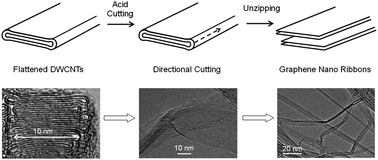Precise unzipping of flattened carbon nanotubes to regular graphenenanoribbons by acid cutting along the folded edges†
Abstract
Precise unzipping of

* Corresponding authors
a
Key Laboratory of Advanced Ceramics and Machining Technology Ministry of Education, School of Materials Science and Engineering, Tianjin University, Weijin Road 92, Nankai District, Tianjin 300072, P. R. China
E-mail:
liyali@tju.edu.cn
Tel: +86-22-27402187
Precise unzipping of

 Please wait while we load your content...
Something went wrong. Try again?
Please wait while we load your content...
Something went wrong. Try again?
Y. Kang, Y. Li and M. Deng, J. Mater. Chem., 2012, 22, 16283 DOI: 10.1039/C2JM33385F
To request permission to reproduce material from this article, please go to the Copyright Clearance Center request page.
If you are an author contributing to an RSC publication, you do not need to request permission provided correct acknowledgement is given.
If you are the author of this article, you do not need to request permission to reproduce figures and diagrams provided correct acknowledgement is given. If you want to reproduce the whole article in a third-party publication (excluding your thesis/dissertation for which permission is not required) please go to the Copyright Clearance Center request page.
Read more about how to correctly acknowledge RSC content.
 Fetching data from CrossRef.
Fetching data from CrossRef.
This may take some time to load.
Loading related content
